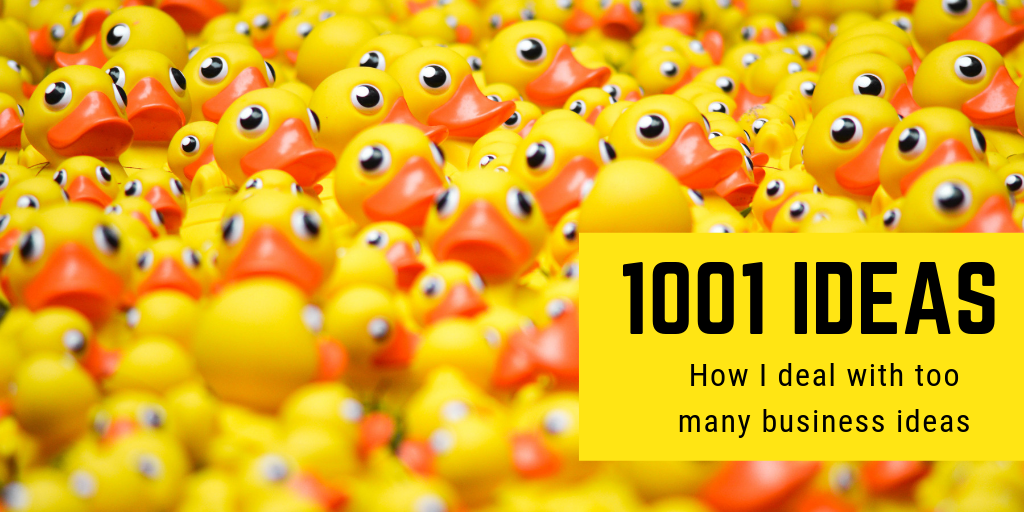
Photo by Andrew Wulf on Unsplash
Some people struggle because they have too many business ideas, others struggle because they have none. Some (I believe few) fortunate of us, have that ONE idea they are passionate about and that works out.
I am the kind of person, who each day has a new business idea. Today, I share with you my personal tips that help me to still make progress, despite the “distracting” ideas.
My approach is probably contradictory to a lot of business advice out there. And that’s why you should read it. We are all different, and maybe my approach is more valuable to you than the off-the-shelf advice you already read in every other business book.
At night, the business ideas strike
For me, it goes like this. Each night, I have one new business idea. My husband already laughs when I tell him my newest and obviously awesome business idea – first thing in the
Too many business ideas are distracting
Too many ideas are definitely a distraction. Each one of them is that new shiny thing that calls me. The problem is that once I start working on it, another new idea calls for my attention the
I only take notes of my business ideas. I rarely take action upon a new idea. I have this ever-growing list of business ideas. The list grows and grows, but I think that’s okay. I do groom the list from time to time. But, as all the ideas take is a few kilobytes of storage, I feel okay having them just stay in my note app. I also write down variations of the same idea. I’ll show you later why.
Too many business ideas are a sign of search mode
I believe I have so many ideas because I am still in search mode. I haven’t settled for anything yet. Yes, I am already working on two different business ideas right now, but it is early on and I’m not sure about them. None of them is profitable yet (a bit by design, but more on that in another post).
I see some of you screaming. How can you do that? Why are you building something you aren’t sure about? Shouldn’t you spend your time working on THE one great business idea?

Photo by Kate Stone Matheson on Unsplash
You have to know yourself first
Yes, and no. Sure, if I had the feeling I found this one, great, awesome idea, I would focus completely on it. But, before I spend my days chasing, searching or waiting for that one idea to hit, I rather do. And in addition, despite having so many ideas, I haven’t found myself as a founder, as an entrepreneur yet. This makes it hard to select and focus on one of those ideas. It even makes it hard to recognize that an idea is
Entrepreneurship is a journey not an end goal
And I think it is okay that I do not know exactly where my path leads me. Many people just pretend they have it all figured out. Many even pretend they figured everything out before they even have started.
I go by the saying, the more you know, the more you know you don’t know. It was true for my journey obtaining my Ph.D., and it is true now.
I for my part, haven’t decided yet how I want to spend my time as an entrepreneur. I know quite a few things I love doing, and I have a rather large skill set. Despite that, I am not sure how my business should exactly look like. Which kind of business would make me happy?
To get started you have to take a leap at an idea
It’s like standing in front of this large fridge in the supermarket. I am confronted with 60+ different yogurts, and I just can’t decide. And it is okay to take the time and read the ingredients. At least for a while. Until you are satisfied enough to take one, bring it home and give it a try.
At one point, you have to dare a leap. Even though you can’t be sure it was or is the right choice. But, a decision is better than not making a decision.
One step at a time
It’s a common saying that consistent work leads to success. And also that with one step at a time, we reach our goals. I believe that both sayings are true. That’s also how I wrote my Ph.D. thesis. One sentence, at a time. One chapter, at a time.
So, whenever I get lost in all the if’s and how’s and when’s, I focus on what I can do today. The rest will follow. This one idea won’t just show up at my doorstep. The business and I will evolve over time.
Everybody’s journey is different, and that’s good. My entrepreneurship story starts with me working on two business ideas simultaneously. I work on them because one idea is the current most concrete business idea I have – with a lot of idealism fueling it. The other idea is a prerequisite for many
Working towards success, each and every day
I am doubtful if the ideas work out the way I want them to. But, I am not worried about my long-term success. Because, while working on my ideas, I acquire so many new skills. I am ramping up. And maybe one of those ideas will become THE idea. Or, maybe, THE one idea will strike me one night.
But you know what? I will be ready by then. Because I work consistently. I show up each and every day. And that effort can only be beneficial and lead to success in the long-term.

Photo by David Beatz on Unsplash
Timeboxing and committing to ideas
The most important strategy I have, when dealing with too many business ideas, is to give a business idea it’s own (limited) time to grow and evolve.
The timeboxing has to be combined with goal setting. So, I set a certain goal and the desired outcome for a given time period.
For example, my product idea was timeboxed right from the beginning. The first phase was just from the beginning of December to the beginning of January.
In this time, I tested the waters. I got first reactions and traction, and also developed my own feeling for the idea. I started understanding it’s potential and the way my business would look like if it’s working out in its current (designed) form. Because those signals have been very positive, I went full speed in January and made a first real MVP implementing the idea.
Good things take time
I wanted to launch the product by February, and then get customer feedback and evolve the product further. And that’s what I did. The feedback was positive and the product is in a good early MVP state. That’s why I entered the next timebox period.
It is way too early to say whether the business idea will work out or not. Therefore, I am still thinking about other options. But, it also means, I have to give it some time, and real effort. So currently, I plan to spend time on this idea until the end of the year. The success of the business depends on my ability to achieve good results from my SEO efforts. And to know, whether my efforts are fruitful or not, will take time.
Diversify your business idea portfolio
At the same time, I work on another business idea of mine. It is less concrete. It’s maybe not even a business idea. But, it is a prerequisite for so many business ideas on my list.
Many ideas on my list evolve about my passion, knowledge, and expertise with software engineering. A recurring pattern, so to say. And, the prerequisite for many business ideas (including consultancy, freelance work or teaching) is to have a strong personal brand. It’s fundamental to my success having a good reputation in the tech and software engineering world.
That’s why I set time aside, to gear up and build up my online reputation in this field. Further, it is also my safety net. Should things not pan out as expected. By having a strong personal brand, I have it easier to get hired
Being open to see and jump on opportunities
Finally, if I see an opportunity that can’t be missed, I take a leap and test one of the business ideas on my list. This happened to me, for example, two weeks ago.
Suddenly there was this request in one Facebook group that was directly relevant to one of the craziest ideas on my idea backlog. So, I built a mini MVP and tested the waters. I got over 40 sign-ups on my email list. That’s much more than the 5-10 that I expected.
Not only timeboxed but ready to be ditched
For the first week, this effort was definitely distracting me quite a bit. But, I feel it is worth it.
After building the initial MVP – which took only two full days – I now allow myself to spend a maximum of half a day per week on this. I told the other interested parties that signed-up that I have a waiting list. By not serving them right now, I risk losing their interest. But, that’s okay. That’s the amount of time I am willing to spend now to test this idea. Not more and not less.
I am also ready to ditch this whole idea within a blink of an eye.
My main mantra for this experiment is: “No commitment from my side”. As soon as I do not see value in spending my time on this, I stop all efforts and pick something else to experiment.
Juggling three balls, or business ideas
So, to summarize, I am currently working on one project (a SAAS or PAAS) 70-80% of my time. I spend around 20% on building my personal brand because that is a prerequisite for quite a few business ideas I have on my list. And finally, I spend 10% of my time testing the waters and experimenting with other ideas. The percentage of time I spend on the first two ideas changes over time depending on how I progress and how much traction I see.
I wanted to abstract my approach from my own situation to give you a guideline to follow if you want to implement a similar approach.
Here is, how I handle my 1001 business ideas
-
Being kind to myself.
Each time a new “brilliant” idea strikes, I am grateful and take it with humor. I don’t beat myself up because I am not laser sharp and focused. Having ideas is a blessing. I perceive it as such. -
Keeping track of business ideas.
I write each business idea down into a list. If ideas come up several times, I also make notes of that. In addition, I keep track of ideas that come up in different variations. -
I do not act upon business ideas.
Most importantly, I do restrain the urge to act upon business ideas immediately. Otherwise, I’d be jumping around with no real progress and no momentum. -
Identifying prerequisites and patterns.
From time to time, I groom and sort the ideas list. One outcome of this grooming and sorting activity is another list with similarities and prerequisites that ideas have in common. This list mentions things like skills, technologies or audiences I need to make business ideas a reality. -
Goal setting and action plan.
I elaborate an action plan for the common patterns and do act on those patterns, instead of the business ideas. For me, for example, the common patterns are certain technologies and certain tools I will be using. Another commonality is my personal brand. So, the time that I spend working on an idea that involves learning some of those prerequisites, I actually also work on a few other ideas. -
Timeboxing.
I set boundaries in terms of time periods I am working on a business idea and I also look at the goals I want to reach in that time period. I use the goals to reevaluate my time commitments and next steps for each of my projects. It also drives my day to day tasks and prioritization. -
Dedicated time for experimentation.
I allow myself some time to play and experiment. Currently, I spend around 10% of my time playing and experimenting. -
No-ditch-rule or the no-discourage-rule.
Once I commit to an idea, I work on it. I do not ditch the business idea at the moment that something new and shiny comes along or if the progress is slow or difficult. During the specified time period, I also do not let myself get discouraged from working towards my goal. -
Working towards long-term success.
I am full of product doubt. That means, I am doubtful if my business ideas will work out. But, what let’s me sleep at night and be so positive about my future is that all my goals are tangible. I designed them in a way that is made for long-time success. That’s also the essence of my strategy: Working with uncertainty and still making sure it amounts into success. In particular, this means, that I always ensure that by building up a business, I build up my skills at the same time. -
Be open to changes.
Even though I say I do not change the business idea I am working on, I am ready to let go. Well, life isn’t black and white. Right? If a much better business idea comes along, I am ready. But, I am not jumping each day/week/ or month on something new. That’s what the experimentation phase is made for. Testing the waters.
If that strategy will work out? Well, we will see. It’s not a proven strategy, cause I am in it – in my journey from passion to business – right now. But, I can say, I have too many business ideas, and I manage to make quite some momentum on working on one main business idea. Things come along. So, it’s working – for me.
I hope it was helpful to you to hear how I deal with too many business ideas. If it resonated, or you have a completely different approach why don’t you send me an email? I’d be super interested in hearing about your approach and experience with dealing with too many business ideas.
Enjoyed the article or curious about how my journey progresses? Sign-up to my newsletter.
Leave a Reply